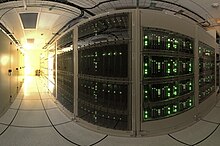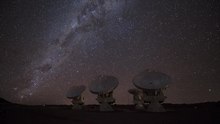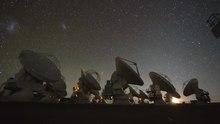Atacama Large Millimeter / submillimeter Array
|
ALMA telescope |
|
|---|---|

|
|
| ALMA antennas at night under the Magellanic Clouds | |
| Type | Interferometer radio telescope |
| Location |
San Pedro de Atacama
|
| height | 5030 m above sea level M. (antennas) |
| Geographic coordinates | 23 ° 1 ′ 59.9 ″ S , 67 ° 45 ′ 0 ″ W |
| wavelength | 0.32 to 3.6 mm |
| Aperture |
|
| construction time | 2004 to 2014 |
| Installation | 2013 |
The Atacama Large Millimeter / submillimeter Array ( ALMA ) is an international radio telescope - Observatory in the northern Chilean Andes . Its antenna system consists of 66 transportable, adjustable parabolic antennas , mostly 12 m in diameter, which can be distributed over distances of up to 16 km and connected to an interferometer radio telescope . The antennas are located near San Pedro de Atacama , in the Chajnantor plateau, at more than 5000 m above sea level. M., where the thin and extremely dry earth's atmosphere is particularly permeable to radio waves. The object of observation is the cold interstellar matter , for researching the formation of stars and planets. The radio telescope was built in an international cooperation and is operated jointly by ESO , AUI / NRAO and NAOJ .
Overview

ALMA consists of 66 high-precision antennas and observes at wavelengths between 0.32 and 3.6 mm. The interferometer has a significantly higher sensitivity and resolution than any other submillimeter telescope. The high sensitivity is achieved by the large number of individual telescopes that make up the interferometer.
The antennas can be moved across the Chajnantor plateau and positioned at intervals of 150 m to 16 km. This makes it possible to use ALMA as a variable “zoom telescope”, similar to the Very Large Array (VLA) in New Mexico , USA. The antennas are moved with the two transporters “Otto” and “Lore” (by Scheuerle , with 14 pairs of wheels), which can position 50 of the 12 m antennas of the main array with an accuracy of a few millimeters and place them on concrete base plates.
The antenna manufacturers are European, North American and East Asian partners in the project. The Americans and Europeans each provide 25 of the 12-meter antennas that make up the main array. East Asia supplies a total of 16 antennas (four 12 m antennas and 12 antennas, each 7 m in diameter). These form a smaller interferometer, the Atacama Compact Array (ACA), part of the ALMA interferometer.
Thanks to the smaller 7 m antennas, the ACA can observe a larger area than the main array at the same frequency. Since they are closer together, pictures of objects of greater extent can be taken. Together with the main array, ALMA's ability to observe large fields of view is expanded.
ALMA's receivers operate in the frequency bands between 30 and 950 GHz. Due to the high altitude and the low humidity at the location, the earth's atmosphere is sufficiently permeable for these frequencies.
The tasks of ALMA include researching the areas where planets and stars formed in cold interstellar clouds and protoplanetary accretion disks . Millimeter waves are particularly well suited to penetrating extensive clouds of gas and dust that cover the areas where stars and planets are formed. Infrared galaxies in the early universe, supermassive black holes and galaxy formation are other important research areas of ALMA. In addition, ALMA should help to answer important questions in the study of dark matter and dark energy .
Other submillimeter telescopes are working at the ALMA site, including the Atacama Pathfinder Experiment . Over the next few years, the Cerro Chajnantor Atacama Telescope , a large single telescope (25 m diameter) for the subsequent shorter sub-millimeter range of 0.03 to 3 millimeters wavelength, will also be built there.
history
ALMA started out in three astronomical projects: the US Millimeter Array (MMA), the European Large Southern Array (LSA) and the Japanese Large Millimeter Array (LMA).
The first step on the way to ALMA was taken in 1997 when the US National Radio Astronomy Observatory (NRAO) and the European Southern Observatory (ESO) initiated a joint project that was to combine MMA and LSA. The combined interferometer should combine the sensitivity of the LSA with the broad frequency range of the MMA. ESO and NRAO worked together in technical, scientific and organizational groups to define and organize a project between the two organizations with the participation of Canada and Spain.
Finally, on February 25, 2003, the North American and European partners signed the ALMA agreement. On September 14, 2004, ALMA and the National Astronomical Observatory of Japan (NAOJ) signed an agreement whereby Japan became another official partner of ALMA. According to this agreement, Japan should supply the ACA and receivers for three additional frequency bands.
For political reasons it was decided that three different antenna types should be developed and built by the North American, European and East Asian partners. Although different approaches were chosen, all three antenna types meet the strict requirements of ALMA.
Today ALMA consists of a collaboration between Europe, North America and East Asia. The work is funded by ESO, the National Science Foundation (NSF) in the USA, the National Research Council of Canada (NRC), and the National Science Council (NSC) in Taiwan. Construction and operations are managed by ESO for Europe, NRAO for North America and NAOJ for East Asia. The Joint ALMA Observatory (JAO) combines the management and organization of the construction, commissioning and ongoing operation of ALMA.
ALMA collected the first data as part of a test run in October 2009. Scientific operations began at the beginning of October 2011, although ALMA was only a third complete. Already at that time, according to ALMA, one was "already much better than anything else". But only when it is fully operational will ALMA “really show its strengths”, according to a local astronomer at the end of 2012. In 2011, several submillimeter telescopes with four bands from 84–116 GHz, 211–275 GHz, 275–373 GHz went into operation and 60-720 GHz. The first images obtained with ALMA were published on October 3, 2011. On March 13, 2013, ALMA - almost completely completed - was officially put into operation. In June 2014 the last of 66 planned antennas was installed.
With costs of over a billion US dollars, it is the most expensive and largest project in ground-based astronomy to date.
First observation results
During test observations in the summer of 2011, enough antennas were in operation to take the first images with ALMA. These gave a foretaste of what to expect from the new interferometer after completion.
The observations were directed towards the Antenna Galaxies , two colliding galaxies with dramatically warped shapes. Although ALMA did not observe the entire range of the galaxies, the images are the best results of these galaxies ever taken in the sub-millimeter range. They show clouds of cold, dense dust in which new stars are born - details that cannot be observed in the visual realm of the light spectrum.
Especially in the 86 GHz band (3.5 mm) VLBI-capable, ALMA took part in the EHT network for the first time on April 3, 2017 - Sagittarius A * continues to be symmetrical.
Alma is a central part of the Event Horizon Telescope project and was one of the telescopes of the global network, with the 2017 (published in April 2019), the first direct images of a black hole in M87 arrive.
ALMA Regional Center (ARC)
The ALMA Regional Center (ARC) serves as a contact point between the scientific users of the telescope in the member countries and the JAO. The ARC is further divided into the three geographic regions of the project: Europe (led by ESO), North America (led by NRAO), and East Asia (led by NAOJ). The European ARC is also divided into ARC nodes, which are distributed throughout Europe in Cologne-Bonn, Bologna, Ondřejov, Onsala, Grenoble, Leiden and Manchester.
The main task of the ARC is to support the scientific community in the preparation of observation requests, to ensure that all observation programs effectively achieve their scientific goals, to maintain a help forum, to provide data to the scientists, to maintain the ALMA archive and the scientists to contribute to support data processing.
Philatelic
On December 6, 2018, Deutsche Post AG issued a postage stamp with a face value of 145 euro cents with the image of the ALMA observatory. The design comes from the graphic designer Andrea Voß-Acker from Wuppertal.
Web links
- Official ALMA site (English)
- ALMA site of ESO
- ALMA website of the NRAO (English)
- ALMA website of the German ARC (English)
- ALMA site for UK (English)
- ALMA site of the National Astronomical Observatory of Japan (English)
- Eso Observatory: The movie ALMA - In Search of our Cosmic Origins on YouTube (English)
Individual evidence
- ↑ [email protected]: ALMA - the Atacama Large Millimeter / submillimeter Array. Retrieved February 29, 2020 .
- ↑ Alma antennas collect data first. BBC News , November 17, 2009, accessed March 13, 2013 .
- ↑ ALMA Opens Its Eyes eso.org, accessed August 7, 2014.
- ↑ Peter Prantner: "ALMA is worth the money". In: orf.at . March 6, 2013, accessed April 2, 2013 .
- ↑ Alma Observatory: New giant telescope throws a view into space . In: focus.de , October 3, 2011, accessed October 4, 2011.
- ↑ Andreas Neuhaus / Hannah Fuchs: Space: The “Alma” super telescope is ready to go. Deutsche Welle , March 13, 2013, accessed on March 13, 2013 .
- ↑ La última antena del observatorio Alma llega a los 5,000 metros de altura . In: La Tercera . June 16, 2014.
- ↑ ALMA - In search of our cosmic origins . In: eso.org , accessed October 4, 2011.
- ↑ Looking towards the Big Bang from Chile October 5, 2011, Die Zeit online, accessed on September 29, 2015
- ↑ Sara Issaoun et al .: The size, shape, and Scattering of Sagittarius A * at 86 GHz: First VLBI with ALMA. ApJ, 2019, doi: 10.3847 / 1538-4357 / aaf732 , arXiv: 1901.06226 .





